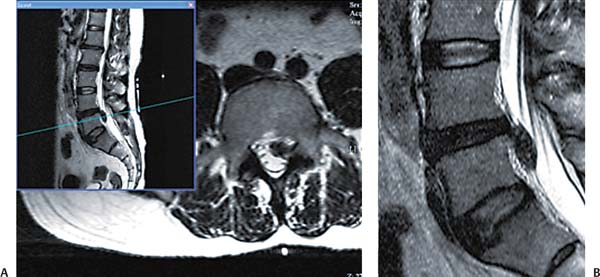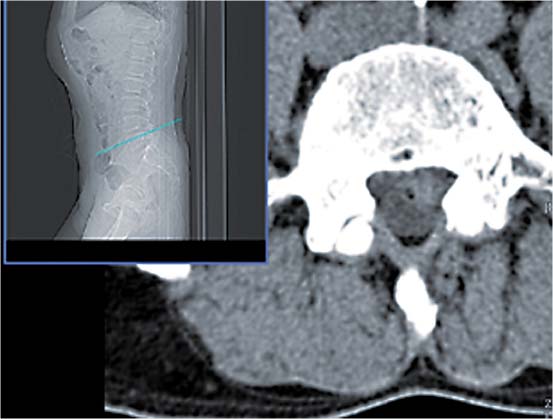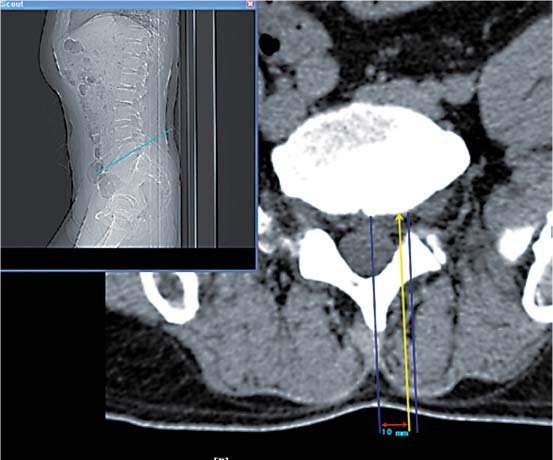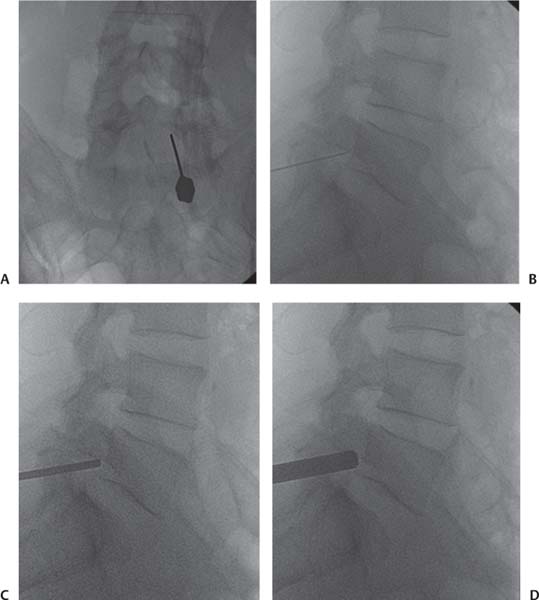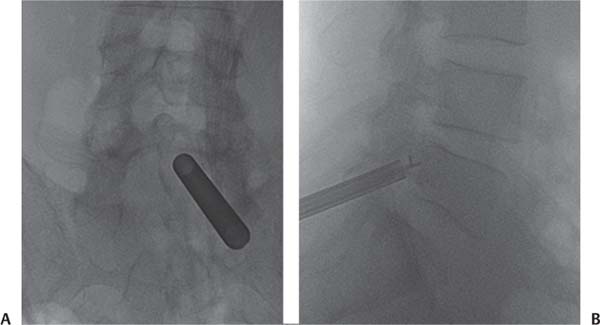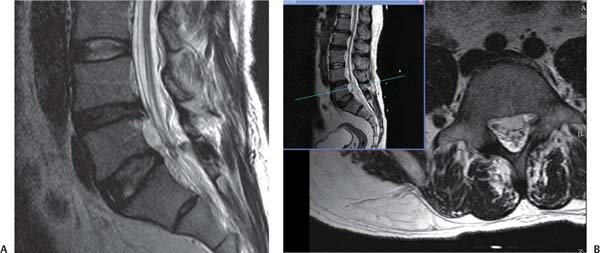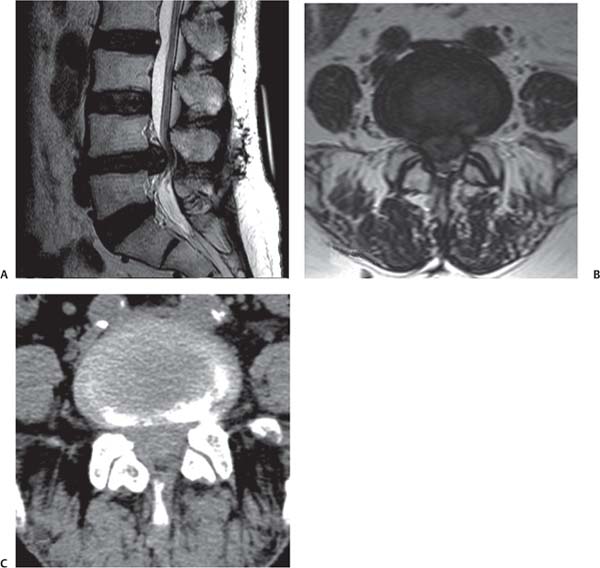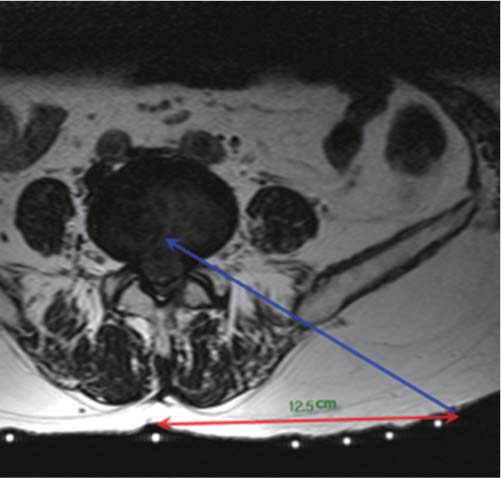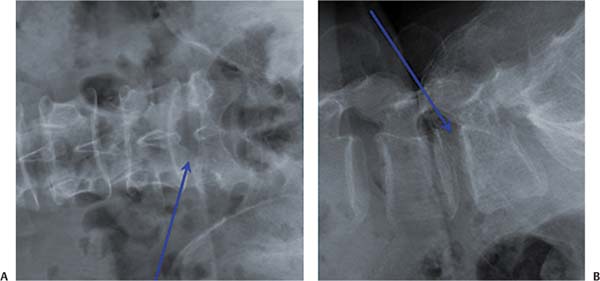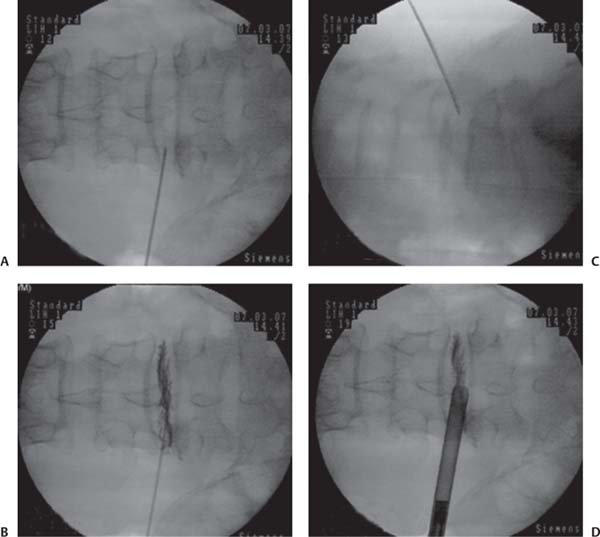19 Case Presentations and Surgical Technique: Special Lumbar Cases • A 51-year-old man presented with left leg pain along the L5 dermatome lasting 6 weeks. • The visual analog scale (VAS) result was 8/10 for left leg pain and 5/10 for back pain. • Sagittal and axial magnetic resonance imaging (MRI) showed a left-side high-grade downward-migrated disk herniation at L4-L5 (Fig. 19.1). A computed tomo-graphic (CT) scan also showed a soft disk (Fig. 19.2). • The safe zone for needle insertion in this case is at the shoulder region of the S1 nerve root. Figure 19.3 shows the intended trajectory and target point for insertion of the needle (caudal to cranial direction). • A preoperative x-ray shows a wide interlaminar space between L5 and S1, which is beneficial in reaching the downward-migrated disk fragment through the intended trajectory (Fig. 19.4). 1. The needle is inserted in the shoulder region with the needle tip close to the medial aspect of the facet joint (Fig. 19.5A). 2. An upward angle of the needle is required over the disk space (Fig. 19.5B–D). 3. The working cannula is placed over the needle (Fig. 19.6A). 4. The endoscopic forceps are then introduced to grasp the upward-migrated disk fragment (Fig. 19.6B). • After inserting the endoscope, epidural fat and the outer surface of the disk fragment are seen (Fig. 19.7A). • The radiofrequency probe is used to remove the ligamentum flavum (Fig. 19.7B). • The endoscopic forceps are then used to grasp the upward-migrated disk fragment (Fig. 19.7C). Fig. 19.1 Axial (A) and sagittal (B) MRIs showing a left-side high-grade downward-migrated disk herniation at L4-L5. Fig. 19.2 CT scan revealing a soft disk. Fig. 19.3 CT image showing the appropriate determination of the needle trajectory. The yellow arrow shows the intended trajectory and target point for insertion of the needle. Fig. 19.4 Preoperative AP (A) and lateral (B) x-rays showing a wide interlaminar space between L5 and S1, which is beneficial in reaching the downward-migrated disk fragment through the intended trajectory (red arrows). Fig. 19.5 Intraoperative AP (A) and lateral (B–D) fluoroscopic views showing needle placement. Note the upward angle of the needle over the disk space. Fig. 19.6 (A) Intraoperative AP fluoroscopic view showing the working cannula in the proper position. (B) Intraoperative lateral fluoroscopic view showing the endoscopic forceps grasping the upward-migrated disk fragment. Fig. 19.7 Intraoperative endoscopic views (1 o’clock is lateral, 4 o’clock is caudal, 7 o’clock is medial, 10 o’clock is cranial). (A) The initial endoscopic view includes epidural fat and the outer surface of the disk fragment. (B) The radiofrequency probe is seen as it is used to remove the ligamentum flavum. (C) The endoscopic forceps are then seen grasping the migrated disk fragment. (D) The posterior longitudinal ligament (PLL), L5 nerve root, and L5 vertebral body are visible after removal of the herniated fragments. Ann, annulus. Fig. 19.8 Postoperative sagittal (A) and axial (B) MRIs indicating that the downward-migrated disk fragment was completely removed. • After the herniated fragments are completely removed, the posterior longitudinal ligament, L5 nerve root, and L5 vertebral body can be visualized (Fig. 19.7D). • The preoperative MRI revealed a ruptured disk herniation at the central L4-L5 level. A CT scan also showed a soft disk (Fig. 19.9). • Postoperative imaging confirmed the complete removal of the downward-migrated disk fragment (Fig. 19.8). • The expanded dural sac and nerve root are clearly visible on the postoperative MRI after the complete decompression performed in this case. • The skin entry point is caudal to the index level for removal of the upper-level downward-migrated disk. • Performing preoperative diskography with indigo car-mine transforaminally through L4-L5 can be useful in identifying the ruptured fragment. • A 58-year-old man presented with left leg pain along the L5 dermatome and low back pain. • The VAS was 8/10 for back pain and 8 to 9/10 for left leg pain. • The patient had undergone a previous operation 1 year earlier. • Axial MRI scans are used to determine the skin entry point, the intended trajectory of the needle, and the distance from the midline. The distance of the skin entry point from the midline is 12.5 cm, and the cranial to caudal angle is 8 degrees (Fig. 19.10). • The intended position of the needle is shown in Fig. 19.11. 1. There are two main considerations in determining the placement of the needle: • Site of the annular puncture: For a lower lumbar disk herniation, the annular puncture must be made at the medial pedicular line and not the midpedicular line as in cases involving the upper lumbar disks. • Inclination of the needle trajectory: The needle is directed downward or upward depending on whether it is a downward- or upward-migrated fragment. 2. The needle tip lies at the posterior vertebral line in the inferior part of the disk space (Fig. 19.12A,B). 3. Diskography is performed to verify the extent of the herniation (Fig. 19.12C). This is especially important in revision cases such as this. 4. After diskography is completed, the working channel is introduced over the needle to the midline as seen on an intraoperative anteroposterior (AP) fluoroscopic view (Fig. 19.12D). Fig. 19.9 Preoperative sagittal (A) and axial (B) imaging showing a ruptured disk herniation at the central L4-L5 level. (C) Preoperative CT scan showing a soft disk. Fig. 19.10 Axial MRI view showing proper determination of the skin entry point and needle trajectory (arrows). Fig. 19.11 AP (A) and lateral (B) fluoroscopic views with the intended needle position drawn (arrows). Fig. 19.12 The needle tip lies at the posterior vertebral line in the inferior part of the disk space as shown in AP (A) and lateral (B) fluoroscopic views. (C) Diskography is performed. (D) The working cannula is introduced to the midline as seen in the AP fluoroscopic view.
L4-L5 Level Highly Downward Migrated Disk Herniation
Clinical Findings
Preoperative Plan
Surgical Procedures
Endoscopic Findings
Results
Tips
L4-L5 Level Central Ruptured Disk Herniation
Clinical Findings
Preoperative Plan
Surgical Procedures
Endoscopic Findings
Stay updated, free articles. Join our Telegram channel

Full access? Get Clinical Tree


